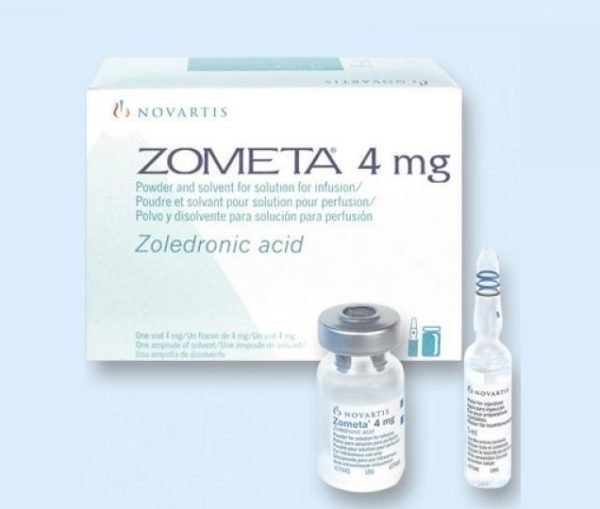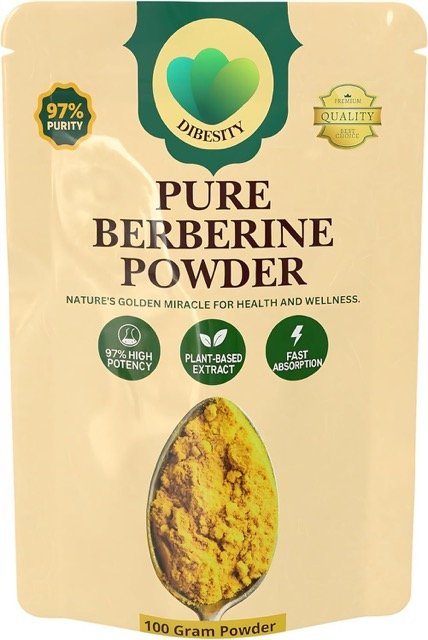A bisphosphonate known as Zometa (Zoledronic Acid) prevents cancer-induced osteoclastic activity and skeletal calcium release, which in turn prevents bone resorption. It is recommended for the following health issues:
-
ln combination with conventional antineoplastic therapy for the treatment of bone metastases from solid malignancies.
-
Patients taking systemic glucocorticoids for the treatment and prevention of glucocorticoid-induced osteoporosis (in a daily dose of 7.5 mg or more of prednisone for at least 12 months).
-
Treatment of hypercalcemia of malignancy. (The efficacy has not been established in patients with hyperparathyroidism and other non-tumor causes of hypercalcemia)
-
Treatment of multiple myeloma with osteolytic lesions.
-
For the treatment of osteoporosis in men
-
In terms of reducing metabolic activity and skeletal aches, it is thought to be the most effective bisphosphonate for the treatment of Paget's disease. It is considered by some experts as the treatment of choice.
-
Off Label Uses of Zoledronic include:
-
Adults receiving adjuvant therapy for breast cancer
-
to stop the bone loss that aromatase inhibitors cause in postmenopausal women with breast cancer.
-
to stop bone loss in recipients of kidney transplants
-
for the purpose of preventing bone loss in individuals with prostate cancer that is brought on by androgen deprivation therapy.
-
Zoledronic acid Dose in Adults
Note: To lower infusion-related hypersensitivity reactions, acetaminophen or ibuprofen must be given to patients at least 30 minutes before the infusion. Calcium and vitamin D supplements should be taken daily by patients being treated for osteoporosis, bone metastases from solid tumours, multiple myeloma, and Paget disease.
Dose for treating Bone metastases from solid tumors (Zometa):
- Every three to four weeks, 4 mg intravenously.
Dose for treating Bone metastases due to breast cancer or prostate cancer (off-label dosing):
- IV administration of 4 mg once every 12 weeks.
Dose in the treatment of early breast cancer as adjuvant therapy (off-label):
- Postmenopausal females:
- For three to five years, 4 mg intravenously given once every six months.
Dose in the prevention of bone loss associated with aromatase inhibitor therapy of Breast cancer, (off-label):
- Postmenopausal females:
- 5 years of intravenous infusions of 4 mg every six months.
Dose in the treatment of Hypercalcemia of malignancy (albumin-corrected serum calcium ≥12 mg/dL) (Zometa):
- A single dose of 4 mg intravenous administration.
- Retreatment shouldn't be considered for at least 7 days.
Dose in the treatment of Multiple myeloma osteolytic lesions (Zometa):
- Every three to four weeks, 4 mg intravenously.
Dose in the treatment of Lytic bone disease as per ASCO guidelines:
- For up to two years, take 4 mg every three to four weeks.
- Stable patients might only need less frequent dosing (once every 3 months).
- After two years, treatment may be stopped for such people.
- If there is a relapse or if new skeletal occurrences start, treatment may be continued.
Dose in the treatment of Multiple myeloma (off-label dosing):
- Administration of 4 mg once every 12 weeks.
Dose in the treatment and prevention of glucocorticoid-induced Osteoporosis:
- Females or males: 5 mg intravenous once a year.
Dose in the prevention Osteoporosis:
- Postmenopausal females: Reclast 5 mg intravenously given once every two years, or 5 mg all at once (Aclasta [Canadian product]).
Dose in the treatment Osteoporosis:
- Males or postmenopausal females: 5 mg intravenous once a year.
Note:
- The length of the course of treatment has not been well researched.
- Patients at low risk of fracture maybe given a drug-holiday after three years of treatment.
- Postmenopausal women at high risk of fractures may extend treatment for up to 6 years.
- Similar treatment recommendations may be used in older males.
Dose in the treatment of Paget disease:
- 5 mg intravenous as a single dose.
Re-treatment:
- Patients with symptoms, those who received an unsatisfactory response, and those who demonstrated a biochemical recurrence may be candidates for re-treatment (raised alkaline phosphatase).
- It is not usually advised to undergo intensive re-treatment based merely on elevated biochemical markers.
- Re-treatment is rarely necessary within 5 years, and a single dose of zoledronic acid has been found to suppress biochemical indicators for up to 10 years.
Dose in the prevention of Postrenal transplant bone loss (off-label):
- 4 mg intravenously in weeks two and three following engraftment
Dose in the prevention of bone loss associated with androgen deprivation therapy Prostate cancer (off-label):
- Either 4 mg intravenously every three months for a year, or 4 mg every year.
Zoledronic acid Dose in Childrens
Dose in the treatment of primary or secondary Osteoporosis:
Note: Give acetaminophen or ibuprofen 30 minutes before and 6 hours after the infusion to avoid medication reactions associated to the infusion.
-
Children <2 years:
-
First dose:
- 0.125 mg/kg/dose intravenous.
-
Maintenance (to begin 3 months after the first dose):
- 0.025 mg/kg/dose intravenous every 3 months.
-
-
Children ≥2 years and Adolescents:
-
First dose:
- 0.125 mg/kg/dose intravenous.
-
Second dose (3 months after the first dose):
- 0.025 mg/kg/dose intravenous.
-
Maintenance (to begin 6 months after first dose):
- 0.05 mg/kg/dose intravenous every 6 months.
- The maximum dose is 4 mg/dose.
-
-
Dose adjustment based on lumbar spine bone mineral density (BMD) Z score:
- Children ≥2 years and Adolescents:
-
BMD Z score >−2:
- Decrease dose to 0.025 mg/kg/dose every 6 months.
-
BMD Z score >0:
- Decrease dose to 0.025 mg/kg/dose every 12 months.
-
- Children ≥2 years and Adolescents:
Pregnancy Risk Factor: D
- Although the excretion via the placental barriers is unknown, it is possible for fetal drug exposure to occur.
- Women of childbearing age should not use bisphosphonates.
- Premenopausal women suffering from osteoporosis should not use it.
- Before and after receiving zoledronic acid medication, it should be urged for women who are sexually active to utilise an effective form of contraception.
- Premenopausal women should stop using bisphosphonates as soon as they are confirmed to be pregnant.
Zoledronic acid use during breastfeeding:
- It is unknown if Zometa (Zoledronic Acid) can be excreted into breastmilk.
- Because of possible adverse effects on infants, the manufacturer suggests that you stop breastfeeding during therapy.
Zoledronic acid Dose in Renal Disease:
Note: Before each dose, measure serum creatinine.
Non-oncology uses:
-
CrCl 35 to 80 mL/minute:
- Adjustment in the dose is not required, however, it should be used with caution.
-
CrCl <35 mL/minute:
- Avoid its use (contraindicated).
- Avoid its use (contraindicated).
Oncology uses:
-
Multiple myeloma and bone metastases:
-
CrCl of more than 60 mL/minute:
- 4 mg (Adjustment in the dose is not necessary)
-
CrCl 50 - 60 mL/minute:
- Reduce the dose to 3.5 mg
-
CrCl 40 - 49 mL/minute:
- Reduce the dose to 3.3 mg
-
CrCl 30 - 39 mL/minute:
- Reduce the dose to 3 mg
-
CrCl of less than 30 mL/minute:
- Avoid using it (contraindicated).
-
-
Hypercalcemia of malignancy:
-
Mild to moderate impairment:
- Adjustment in the dose is not necessary.
-
Severe impairment (creatinine of more than 4.5 mg/dL):
- Evaluate risks versus benefit
- Evaluate risks versus benefit
-
-
Dosage adjustment for renal toxicity during Zometa (zoledronic acid) treatment:
-
Multiple myeloma:
- If the creatinine rises by 0.5 mg/dl in patients with a normal baseline or by 1 mg/dl in individuals with an abnormal baseline, treatment must be stopped.
- When the serum creatinine is within 10% of the baseline, treatment may be restarted at the same dose.
-
American Society of Clinical Oncology (ASCO) guidelines:
- Renal function deterioration without an apparent cause:
- Withhold treatment.
- When the renal function is within 10% of the baseline, you can resume therapy at the previous dose.
- Unexplained Albuminuria of more than 500 mg/24 hours:
- Withhold treatment and assess the patient after 3 - 4 weeks.
- Treatment may be reinitiated at a slower infusion rate (30 minutes or longer).
- Renal function deterioration without an apparent cause:
-
Zoledronic acid Dose in Liver Disease:
Dose adjustment in patients with liver disease has not been recommended by the manufacturer.
Oncology indications:
Common Side Effects of Zoledronic acid Include:
-
Cardiovascular:
- Hypotension
- Lower Extremity Edema
-
Central Nervous System:
- Headache
- Hypoesthesia
- Dizziness
- Depression
- Agitation
- Insomnia
- Confusion
- Anxiety
- Rigors
- Fatigue
-
Dermatologic:
- Dermatitis
- Alopecia
-
Endocrine & Metabolic:
- Hypokalemia
- Hypophosphatemia
- Hypomagnesemia
- Dehydration
-
Gastrointestinal:
- Weight Loss
- Vomiting
- Abdominal Pain
- Constipation
- Anorexia
- Diarrhea
- Decreased Appetite
- Nausea
-
Genitourinary:
- Urinary Tract Infection
-
Hematologic & Oncologic:
- Neutropenia
- Progression Of Cancer
- Anemia
-
Infection:
- Candidiasis
-
Neuromuscular & Skeletal:
- Weakness
- Limb Pain
- Myalgia
- Back Pain
- Ostealgia
- Paresthesia
- Skeletal Pain
- Arthralgia
-
Renal:
- Renal Insufficiency
-
Respiratory:
- Cough
- Dyspnea
-
Miscellaneous:
- Fever
Less Common Side Effects of Zoledronic acid Include:
-
Cardiovascular:
- Chest Pain
-
Central Nervous System:
- Somnolence
-
Endocrine & Metabolic:
- Hypermagnesemia
- Hypocalcemia
-
Gastrointestinal:
- Dysphagia
- Sore Throat
- Mucositis
- Stomatitis
- Dyspepsia
-
Hematologic & Oncologic:
- Thrombocytopenia
- Pancytopenia
- Granulocytopenia
-
Infection:
- Infection
-
Renal:
- Increased Serum Creatinine
- Respiratory:
- Upper Respiratory Tract Infection
Nononcology indications:
Common Side Effects of Zoledronic acid Include:
-
Cardiovascular:
- Hypertension
-
Central Nervous System:
- Pain
- Fever
- Headache
- Chills
- Fatigue
- Flank Pain
-
Endocrine & Metabolic:
- Hypocalcemia
- Dehydration
-
Gastrointestinal:
- Abdominal Distension'
- Upper Abdominal Pain
- Nausea
-
Immunologic:
- Infusion-Related Reaction
-
Neuromuscular & Skeletal:
- Myalgia
- Osteoarthritis
- Back Pain
- Musculoskeletal Pain
- Limb Pain
- Arthralgia
-
Respiratory:
- Flu-Like Symptoms
Less Common Side Effects of Zoledronic acid Include:
-
Cardiovascular:
- atrial fibrillation
- peripheral edema
- palpitations
- Chest pain
-
Central nervous system:
- vertigo
- rigors
- paresthesia
- malaise
- lethargy
- hypoesthesia
- hyperthermia
- Dizziness
-
Dermatologic:
- hyperhidrosis
- Skin rash
-
Gastrointestinal:
- constipation
- diarrhea
- abdominal discomfort
- vomiting
- dyspepsia
- anorexia
- Abdominal pain
-
Hematologic & oncologic:
- Change in serum protein
-
Neuromuscular & skeletal:
- weakness
- arthritis
- jaw pain
- neck pain
- muscle spasm
- stiffness
- shoulder pain
- joint swelling
- Ostealgia
-
Ophthalmic:
- Eye pain
-
Renal:
- Increased serum creatinine
-
Respiratory:
- Dyspnea
Contraindication to Zoledronic acid Include:
- Responses to zoledronic or any other formulation component that cause allergies
- Hypocalcemia (Reclast only).
- In patients with acute renal impairment, CrCl is 35 mg/min (Reclast only).
- Hypocalcemia that is not corrected at the time of infusion.
- Pregnancy
- Breastfeeding
Warnings and precautions
-
Bone fractures:
- Patients taking bisphosphonates may develop atypical femur fractures.
- Atypical fractures include the subtrochanteric and diaphyseal fractures.
- Patients can experience dull, aching pains weeks or months before the fracture.
- Patients receiving long-term therapy (greater that 5 years) are at greater risk for fractures. However, the benefits outweigh the risks.
- Treatment should be stopped for patients who suffer from an atypical fracture in the femur.
- Additionally, fractures of the contralateral leg should be assessed.
-
Hypersensitivity reactions
- Reports of allergic reactions resulting in urticaria, angioedema, and occasionally anaphylactic reactions or shock have been made.
-
Hypocalcemia:
- It has been linked to severe and potentially life-threatening hypocalcemia cases.
- Patients receiving treatment for Paget's Disease are among those at increased risk for hypocalcemia.
- Patients using Zometa are at a high risk of developing severe hypocalcemia that could be fatal.
- Measurement of serum calcium is crucial before treatment can start.
- Prior to starting treatment, any hypocalcemia in patients with Paget disease, osteoporosis, or other oncology reasons should be treated.
- Therapy should include adequate vitamin D and calcium supplementation.
- Patients with anomalies in the metabolism of calcium or other minerals, such as hypoparathyroidism, thyroid or parathyroid surgery, malabsorption syndromes, or small intestine excision, should be handled carefully.
- Hypocalcemia may occur in patients who have had Zometa infusions for a few days to several months. These are:
- QTc prolongation can cause cardiac arrhythmias.
- Events involving the nervous system, such as tetany, tonic-clonic seizures, or numbness.
-
Influenza-like illness:
- Flu-like symptoms may develop in patients within three days of receiving their first infusion.
- The majority of symptoms resolve within three days, but it can take up to 14.
- Acetaminophen can be used to reduce symptoms.
- You may experience fewer symptoms with each subsequent infusion.
-
Musculoskeletal pain
- Some individuals may experience severe bone, joint, and muscular pain as a result of bisphosphonate therapy. This may last for a few days to several months.
- If patients experience severe symptoms, they should be stopped from receiving treatment.
- Most symptoms disappear once treatment is stopped.
- Some patients who attempted to take the same medication or another bisphosphonate again suffered recurrences.
- Patients who have these symptoms shouldn't receive bisphosphonate medication concurrently.
-
Ocular infection
- Use has been associated with conjunctivitis and orbital inflammation.
- Complex infections can lead to discontinuation of therapy or ophthalmic evaluation.
-
Osteonecrosis in the jaw:
- Patients who have received bisphosphonates have been known to develop osteonecrosis (ONJ) or medication-related osteonecrosis (MRONJ).
- MRONJ is a condition that can be caused by invasive dental procedures, such as tooth extraction, bone surgery and dental implants, cancer diagnosis, concurrent therapy (eg corticosteroids and chemotherapy) and poor oral hygiene.
- The risk of developing breast cancer may rise with prolonged bisphosphonate treatment. It is possible that the risk will be higher if there are more cases (e.g., multiple myeloma or advanced breast carcinoma).
- For the treatment of osteoporosis and cancer, MRONJ has been used with antiresorptive medications (denosumab), antiphosphonates, and antiangiogenic agents (such as bevacizumab or sunitinib).
- People with cancer who undergo antiresorptive therapy have a considerably higher risk of developing MRONJ than patients who receive osteoporosis therapy.
- Additionally, compared to oral bisphosphonates, the risk of MRONJ is greater with IV antiresorptive therapy.
- If oral therapy is used for more than four years, the risk increases.
- Before initiating long-term bisphosphonates therapy, it is important to have preventive and dental exams.
- It is important to delay treatment until you have achieved optimal dental health.
- After Intravenous bisphosphonate therapy has been initiated for oncologic diseases, it is important to avoid procedures that directly inflict the osseous and place dental implants.
-
Aspirin-sensitive asthma:
- Patients with asthma that is aspirin sensitive should be cautious.
- It can cause bronchoconstriction.
-
Metastatic breast cancer:
- Patients with metastatic breast carcinoma may be started on any BMA.
- Patients with metastatic breast carcinoma to the bone can be treated with denosumab, pimdronate and zoledronic acids.
- Once therapy is started, it can be continued indefinitely.
- Patients with severe pain should not take Zometa or any other BMA.
-
Multiple myeloma
- Patients should get bisphosphonate medication, including zoledronic acid therapy, if there is radiographic or imaging evidence of lytic bone disease.
- In individuals with osteolytic disease-related pain or those who are at risk for fractures, zometa may be used as an addition to standard therapy.
- Bisphosphonate therapy may be offered to patients who have not shown radiographic evidence of lytic lesion.
- Zometa may not be recommended for patients with solitary plasmacytoma or indolent meeloma.
- MGUS (monoclonal gammopathy with undetermined significance) does not recommend bisphosphonates unless osteopenia is also present.
- ASCO guidelines recommend that patients receive monthly treatment for up to 2 years, except for very stable patients.
- After 2 years, a treatment vacation may be recommended for responsive patients.
- If there is a relapse, or if new skeletal events happen, treatment may be resumed.
- Patients who have significant bone disease, serum creatinine levels greater than 3 mg/dL, or CrCl 30 mL/min may want to seek other treatments.
- Verify for albuminuria every 3 to 6 months.
- Patients with undiagnosed albuminuria greater than 500 mg/24 hrs should be withheld from receiving any doses until the level is back to baseline. After that, recheck the patient every 3-4 weeks.
- After reinitiation, infusion rate should be increased to 30 minutes.
-
Renal impairment
- For patients with mild or moderate renal impairment, it should be used cautiously.
- Patients with renal failure brought on by hemodialysis could require several Zometa infusions.
- There are several risks of worsening renal disease:
- Severe dehydration
- Preexisting renal compromise
- Concurrent use with diuretics
- other nephrotoxic medications
- Treatment requires adequate hydration (urine output 2L/day).
-
Non-oncology indications
- It is not advised for people with CrCl 35 mg/min or acute renal impairment to take this drug.
- Use only 5 mg doses and infuse for no less than 15 minutes.
- Patients in the following groups are at greater risk of developing renal failure:
- Patients with severe to moderate underlying renal impairment
- Increasing age
- Use of diuretic or nephrotoxic medications concurrently with nephrotoxic medication
- Extreme dehydration before or after the administration of zoledronic acids
- Patients who have used diuretics or who are dehydrated as a result of a fever, sepsis, gastrointestinal losses, or both.
- Before administering Zometa, obtain serum creatinine.
- Patients with impaired renal function may experience more rapid increases in serum creatinine.
- Patients at high risk should have their serum creatinine monitored.
-
Oncology indications
- Dosage modification is necessary when there is renal impairment.
- Patients who have bone metastases or severe renal impairment (serum creatinine > 3 mg/dL, CrCl > 30 mL/min) should not use this medicine.
- Patients with severe renal impairment or hypercalcemia (>4.5 mg/dL) should not be used.
- Cancer patients should not receive single doses of more than 4 mg.
- These patients should not be given rapid infusions (more than 15 minutes).
- It is important to identify and manage dehydration and other nephrotoxic drug use that can cause renal damage.
- Hypovolemia should be treated with diuretics.
- Before each dose, it is important to perform renal function tests.
- If serum creatinine levels rise above 0.5 mg/dL, or if they exceed 1 mg/dL (as this is considered abnormal), treatment should be stopped immediately.
- Treatment should not be stopped until renal function is back to 10%.
Zoledronic acid: Drug Interaction
|
Aminoglycosides |
Enhances the hypocalcemic action of derivatives of bisphosphonates |
|
Angiogenesis Inhibitors (Systemic) |
May intensify the harmful or hazardous effects of derivatives of bisphosphonates. In particular, there may be an elevated risk for jaw osteonecrosis. |
|
Calcitonin |
May enhance Zoledronic Acid's hypocalcemic effects. |
|
Deferasirox |
The hazardous or negative effects of Deferasirox may be increased by derivatives of bisphosphonates. Particularly, there may be a higher risk of GI bleeding or ulcers. |
|
Nonsteroidal Anti-Inflammatory Agents |
May intensify the harmful or hazardous effects of derivatives of bisphosphonates. Concern is raised by both an elevated risk of nephrotoxicity and an elevated risk of gastrointestinal ulcers. |
|
Proton Pump Inhibitors |
May lessen the therapeutic impact of derivatives of bisphosphonates. |
|
Thalidomide |
May enhance Zoledronic Acid's hypocalcemic effects. |
Monitoring prior to and during therapy:
- Prior to initiation treatment, all patients should be evaluated by the dentist and assessed to prevent the risk of osteonecrosis including patients with cancers.
- Pregnancy status should also be assessed in women of reproductive potential prior to its use.
-
Nononcology uses:
- Serum creatinine (and creatinine clearance) before each dose particularly patients with risk factors.
- Prior to each dose, the patient's hydration state should be checked, and they should be properly hydrated..
-
Osteoporosis:
- Assess bone mineral density (BMD) yearly or after 2 years (less frequently in stable patients).
- Patients on glucocorticoid treatment and zoledronic acid therapy, bone mineral density should be evaluated after 6 - 12 months, then every 2 - 3 years.
- Serum calcium
- Serum phosphate
- Serum Magnesium
- 25 Hydroxy-Vitamin D levels
- Measure the height and weight manually
- Assessment for chronic back pain
- Assess for markers of bone turn over.
-
Paget disease:
- To evaluate the efficacy of the medication, measure serum total alkaline phosphatase at 6–12 weeks and again at 6 months. At the conclusion of the course of treatment and then one to two years later, reassess serum total alkaline phosphatase levels.
- Patients with aberrant liver or biliary system functioning may be encouraged to use more precise biochemical markers of bone turnover, such as serum P1NP, NTX, or serum beta-CTx, when an early response to treatment (such as inactive spinal compression) requires evaluation.
- Measure serum phosphorus and magnesium
- Monitor the symptoms of hypocalcemia
- Monitor the patient for pain.
-
Oncology uses:
- Measure serum creatinine before each dose
- Monitor serum electrolytes
- Serum phosphate
- Serum magnesium
- Hemoglobin and hematocrit
- Monitor serum calcium to avoid overtreatment.
- Assess patients with multiple myeloma for albuminuria every 3 - 6 months.
-
Multiple myeloma:
- Monitor serum creatinine and measure creatinine clearance before each dose
- Serum calcium at regular intervals
- Vitamin D levels
- Every three to six months, check urine for albuminuria (24-hour urine for albuminuria may be advised in patients with unexplained albuminuria)
- Until renal function returns to normal, evaluate the patient every 3–4 weeks for total protein and urine protein electrophoresis.
How to administer Zoledronic acid?
- It is available for intravenous administration. Prior to use, it is refrigerated. Before administration, allow the solution to reach room temperature.
- Give it at least 15 minutes to absorb. After it is administered, flush the intravenous line with 10 mL of normal salin
- Do not infuse it with other medications and prior to its administration, hydrate the patient appropriately.
- Patients who develop acute infusion-related reactions lie arthralgia, fever, flu-like symptoms, and myalgia may be given acetaminophen.
- When treating individuals with multiple myeloma, the infusion period should be raised to at least 30 minutes if the treatment was stopped due to unexplained albuminuria.
Mechanism of action of Zometa (Zoledronic acid):
- A bisphosphonate called zoledronic acid prevents the release of skeletal calcium as well as osteoclastic activity.
- This results in bone resorption. It increases the elimination of calcium and phosphorus, which decreases their levels.
- It can also be used to reduce bone turnover by inhibiting osteoclast-mediated osteoclast resorption in osteoporosis patients.
The drug can be found in between 23% and 53% of the population.protein-boundIt is not.
It isn'tMetabolizedAndexcretedThe kidneys keep it intact.
Thehalf-life eliminationIt takes 146 hours.
International Brands of Zoledronic acid:
- Aclasta
- Ai Lang
- Amonzitra
- Blazter
- Blaztere
- Bolenic
- Bonemie
- Bonizol
- Drometa
- Leuzotev
- Metakus
- Oprasta
- Osteomet
- Osteovan
- Ostira
- Reclast
- Sinresor
- Vexonib-4
- Xoleron
- Zerlinda
- Zidronic
- Zinvel
- Zobone
- Zobonic
- Zofaden
- Zoffec
- Zoldonat
- Zoldria
- Zoldron-4
- Zoledra
- Zoledran
- Zolennic
- Zoletalis
- Zoletero-4
- Zolnic
- Zoltero
- Zomegoal
- Zomera
- Zometa
- Zoruxa
- Zova
- Aclasta
- PMS-Zoledronic Acid
- TARO-Zoledronic Acid
- Zoledronic Acid - Z
- Zometa
Zoledronic acid brands in Pakistan:
- Aclasta - Novartis
- Benzole - Amgomed
- Edonax - S.J&G. FazulEllahie
- Kedronico - Oncogene
- Macdronic - Macter
- Rokfos - A. J. Mirza
- Z-Dron - Graton
- Zoldic - CCL
- Zoldria - A. J. Mirza
- Zoldro - UDL Pharma
- Zometa (1 vial - Rs. 16150) - Novartis
Zoledronic Acid [Inj 4 mg] |
|
| Edonax | Ferozsons Laboratoies Ltd. |
| Kedronico | Oncogene Pharmaceuticals Karachi |
| Zoldic | Consolidated Chemical Laboratories (Pvt) Ltd. |
| Zoldria | A. J. Mirza Pharma (Pvt) Ltd |
| Zoledron | Scotmann Pharmaceuticals |
| Zometa | Novartis Pharma (Pak) Ltd |
Zoledronic Acid [Inj 5 mg] |
|
| Edonax | Ferozsons Laboratoies Ltd. |
Zoledronic Acid [Inf 5 mg] |
|
| Aclasta | Novartis Pharma (Pak) Ltd |



.jpeg)





